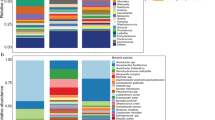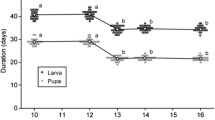Summary
The nature and relative strengths of intra versus interspecific interactions among foraging ladybeetle larvae were studied experimentally by measuring short-term growth rates of predators and reductions in population sizes of prey in laboratory microcosms. In these microcosms, ladybeetle larvae foraged singly or as conspecific or heterospecific pairs, for pea aphids on bean plants over a two-day period. Similarly sized third instar larvae ofHippodamia convergens andH. tredecimpunctata, H. convergens andH. sinuata, andH. convergens andCoccinella septempunctata, were tested in experiments designed to ensure that paired larvae experienced moderate competition. Interspecific competition in these experiments did not differ significantly from intraspecific competition, in that an individual's weight gain did not depend on whether its competitor was heterospecific or conspecific. Furthermore, aphid populations were reduced equally by heterospecific and conspecific pairs. These results suggest that there is little or no difference between intra and interspecific interactions among larvae of these ladybeetles when two similarly sized individuals co-occur on a host plant. Thus, the species diversityper se of assemblages of ladybeetle larvae may have little influence over the short term on the reduction of aphid populations by ladybeetle predation.
Similar content being viewed by others
References
Angalet GW, Tropp JM, Eggert AN (1979)Coccinella septempunctata in the United States: recolonizations and notes on its ecology. Environ Entomol 8:896–901
Banks CJ (1955) An ecological study of Coccinellidae (Col.) associated withAphis fabae Scop. onVicia faba. Bull Entomol Res 46:561–587
Banks CJ (1957) The behaviour of individual coccinellid larvae on plants. Brit J Anim Behav 5:12–24
Brodsky LM, Barlow CA (1986) Escape responses of the pea aphid,Acyrthosiphon pisum (Harris) (Homoptera: Aphididae): influence of predator type and temperature. Can J Zool 64:937–939
Carter MC, Dixon AFG (1984) Foraging behaviour of Coccinellid larvae: duration of intensive search. Entomol exp appl 36:133–136
Carter N, McLean IFG, Watt AD, Dixon AFG (1980) Cereal aphids: a case study and review. In: Coaker TH (ed) Applied Biology, vol 5. Academic Press, London, pp 271–347
Clegg JM, Barlow CA (1982) Escape behaviour of the pea aphidAcythosiphon pisum (Harris) in response to alarm pheromone and vibration. Can J Zool 60:2245–2252
Connell JH (1983) On the prevalence and relative importance of interspecific competition: evidence from field experiments. Amer Nat 122:661–696
Corderre D, Provencher L, Tourneur J-C (1987) Oviposition and niche partitioning in aphidophagous insects on maize. Can Entomol 119:195–203
Creese RG, Underwood AJ (1982) Analysis of inter- and intraspecific competition amongst intertidal limpets with different modes of feeding. Oecologia 53:337–346
Dixon AFG (1959) An experimental study of the searching behaviour of the predatory coccinellid beetleAdalia decempunctata (L.) J Anim Ecol 28:259–281
Dixon AFG (1970) Factors limiting the effectiveness of the coccinellid beetle,Adalia bipunctata (L.), as a predator of the sycamore aphid,Drepanosiphum platanoides (Schr.). J Anim Ecol 39:739–751
Ehler LE (1985) Species-dependent mortality in a parasite guild and its relevance to biological control. Environ Entomol 14:1–6
Ehler LE (1990) Introduction strategies in biological control of insects. In Mackauer M, Ehler LE, Roland J (eds) Critical issues in biological control. Intercept Ltd, Andover, Hants, UK, pp. 111–134
Ehler LE, Hall RW (1982) Evidence for competitive exclusion of introduced natural enemies in biological control. Environ Entomol 11:1–4
Ehler LE, Hall RW (1984) Evidence for competitive exclusion of introduced natural enemies in biological control: an addendum. Environ Entomol 13:v-vii
Elliot NC, Kieckhefer RW (1990) Dynamics of aphidophagous coccinellid assemblages in small grain fields in eastern South Dakota. Environ Entomol 19:1320–1329
Evans EW (1983) Niche relations of predatory stinkbugs (Podisus spp., Pentatomidae) attacking tent caterpillars (Malacosoma americanum, Lasiocampidae). Amer Midl Natur 109:316–323
Evans HF (1976) Mutual interference between predatory anthocorids. Ecol Entomol 1:283–286
Fenchel T, Kofoed LH (1976) Evidence for exploitative interspecific competition in mud snails (Hydrobiidae). Oikos 27:367–376
Frazer BD, Gilbert N, Ives PM, Raworth DA (1981a) Predàtor reproduction and the overall predator-prey relationship. Can Entomol 113:1015–1024
Frazer BD, Gilbert N, Nealis V, Raworth DA (1981b) Control of aphid density by a complex of predators. Can Entomol 113:1035–1041
Gagné WC, Martin JL (1968) The insect ecology of Red Pine plantations in central Ontario. V. The Coccinellidae (Coleoptera). Can Entomol 100:835–846
Gordon RD (1985) The Coccinellidae (Coleoptera) of America north of Mexico. J New York Entomol Soc 93:1–912
Hajek AE, Dahlsten DL (1987) Behavioral interactions between three birch aphid species andAdalia bipunctata larvae. Entomol exp appl 45:81–87
Hassell MP (1978) The dynamics of arthropod predator-prey systems. Monographs in Population Biology, 13. Princeton University Press, Princeton, NJ
Heathcote GD (1978) Coccinellid beetles on sugar beet in eastern England, 1961–75. Plant Pathology 27:103–109
Hodek I (1970) Coccinellids and the modern pest management. Bioscience 20:543–552
Huffaker CB, Simmonds FJ, Laing JE (1976) The theoretical and empirical basis of biological control. In: Huffaker CB, Messenger PS (eds) Theory and practice of biological control. Academic Press, New York, pp 41–78
Keller MA (1984) Reassessing evidence for competitive exclusion of introduced natural enemies. Environ Entomol 13:192–195
Kieckhefer RW, Elliot NC (1990) A 13-year survey of the aphidophagous Coccinellidae in maize fields in eastern South Dakota. Can Entomol 122:579–581
Kirkland AH (1898) Report of the Massachusetts State Board of Agriculture on Gypsy Moths. Boston, Massachusetts, USA
Kring TJ, Gilstrap FE, Michels GJ Jr. (1985) Role of indigenous coccinellids in regulating greenbugs (Homoptera: Aphididae) on Texas grain sorghum. J Econ Entomol 78:269–273
Lack D (1947) Darwin's finches. Cambridge University Press, Cambridge, England
MacArthur R, Levins R (1967) The limiting similarity, convergence, and divergence of coexisting species. Amer Nat 101:377–385
McConnell JA, Kring TJ (1990) Predation and dislodgement ofSchizaphis graminum (Homoptera: Aphididae), by adultCoccinella septempunctata (Coleoptera: Coccinellidae). Environ Entomol 19:1798–1802
Mills NJ (1982) Voracity, cannibalism and coccinellid predation. Ann appl Biol 101:144–148
Morris RF (1972) Predation by insects and spiders inhabiting colonial webs ofHyphantria cunea. Can Entomol 104:1197–1207
Neuenschwander P, Hagen KS, Smith RF (1975) Predation on aphids in California's alfalfa fields. Hilgardia 43:53–78
Obrycki JJ, Tauber MJ (1985) Seasonal occurrence and relative abundance of aphid predators and parasitoids on pubescent potato plants. Can Entomol 117:1231–1237
Obrycki JJ, Bailey WC, Stoltenow CR, Puttler B, Carlson CE (1987) Recovery of the seven-spotted lady beetle,Coccinella septempunctata (Coleoptera: Coccinellidae), in Iowa and Missouri. J Kans Entomol Soc 60:584–588
Polis GA (1981) The evolution and dynamics of intraspecific predation. Annu Rev Ecol Syst 12:225–251
Polis GA, Myers CA, Holt RD (1989) The ecology and evolution of intraguild predation: potential competitors that eat each other. Annu Rev Ecol Syst 20:297–330
Rice ME, Wilde GE (1988) Experimental evaluation of predators and parasitoids in suppressing greenbugs (Homptera: Aphididae) in sorghum and wheat. Environ Entomol 17:836–841
Roitberg BD, Myers JH (1978) Adaptation of alarm pheromone responses of the pea aphidAcythrosiphon pisum (Harris). Can J Zool 56:103–108
Roitberg BD, Myers JH (1979) Behavioural and physiological adaptations of pea aphids (Homoptera: Aphididae) to high ground temperatures and predator disturbances. Can Entomol 111:515–519
Schaefer PW, Dysart RJ, Specht HB (1987) North American distribution ofCoccinella septempunctata (Coleoptera: Coccinellidae) and its mass appearance in coastal Delaware. Environ Entomol 16:368–373
Schoener TW (1983) Field experiments on interspecific competition. Am Nat 122:240–285
Schoener TW (1986) Mechanistic approaches to community ecology: a new reductionism? Amer Zool 26:81–106
Sokal RR, Rohlf FJ (1981) Biometry. WH Freeman and Co, San Francisco
Spiller DA (1984a) Competition between two spider species: experimental field study. Ecology 65:909–919
Spiller DA (1984b) Seasonal reversal of competitive advantage between two spider species. Oecologia 64:322–331
Spiller DA (1986) Interspecific competition betwen spiders and its relevance to biological control by general predators. Environ Entomol 15:177–181
Staines CL Jr., Rothschild MJ, Trumbule RB (1990) A survey of the Coccinellidae (Coleoptera) associated with nursery stock in Maryland. Proc Entomol Soc Wash 92:310–313
Turnbull AL, Chant DA (1961) The practice and theory of biological control of insects in Canada. Can J Zool 39:697–753
Way MJ, Banks CJ (1968) Population studies on the active stages of the black bean aphid,Aphis fabae Scop., on its winter hostEuonymus europaeus L. Ann appl Biol 62:177–197
Wise DH (1975) Food limitation of the spiderLinyphia marginata: experimental field studies. Ecology 56:637–646
Wise DH (1981) Inter- and intraspecific effects of density manipulations upon females of two orb-weaving spiders (Araneae: Araneidae). Oecologia 48:252–256
Wratten SD (1973) The effectiveness of the coccinellid beetle,Adalia bipunctata (L.), as a predator of the lime aphid,Eucallipterus tiliae L. J Anim Ecol 42:785–792
Wratten SD (1976) Searching byAdalia bipunctata (L.) (Coleoptera: Coccinellidae) and escape behaviour of its aphid and cicadellid prey on lime (Tilia x vulgaris Hayne). Ecol Entomol 1:139–142
Author information
Authors and Affiliations
Rights and permissions
About this article
Cite this article
Evans, E.W. Intra versus interspecific interactions of ladybeetles (Coleoptera: Coccinellidae) attacking aphids. Oecologia 87, 401–408 (1991). https://doi.org/10.1007/BF00634598
Received:
Accepted:
Issue Date:
DOI: https://doi.org/10.1007/BF00634598




